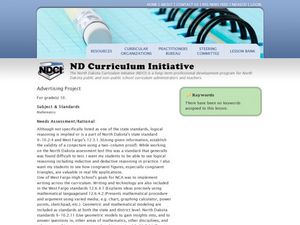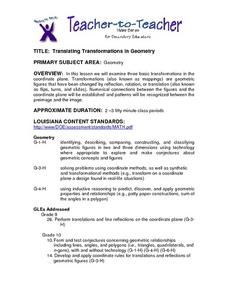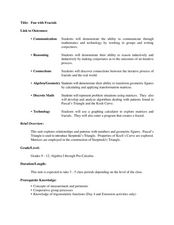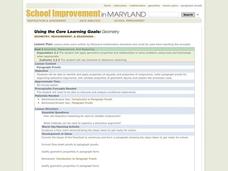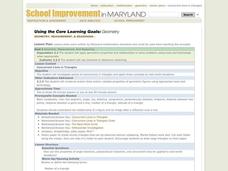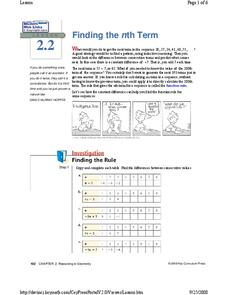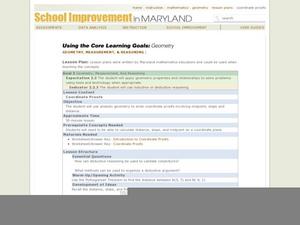Curated OER
Inductive and Deductive Reasoning
Students use logical arguments and inductive reasoning to make or disprove conjectures. After observing a teacher led demonstration, students discover that the deductive process narrows facts to a few possible conclusions. In groups,...
Curated OER
Deductive and Inductive Reasoning
Students differentiate between inductive and deductive reasoning. In this geometry lesson, students identify congruent figures and examine logos for congruency.
Curated OER
Geometry, Measurement & Reasoning
Students construct two-column proofs. In this geometry lesson, students use deductive reasoning and geometric properties to justify given geometric statements. Students compare and contrast proofs.
Curated OER
Deductive Reasoning
Tenth graders investigate deductive reasoning. In this geometry lesson, 10th graders compare and contrast inductive ns deductive reasoning. Students use deductive reasoning to investigate algebraic proof and explore deductive...
Curated OER
Arithmetic Chains
Young scholars complete a chain of numbers given the outcome. In this geometry lesson plan, student use deductive and inductive reasoning to solve problems. They create a formula and ways to predict numbers in the chain without starting...
Curated OER
U Boat Hunt
Students recognize patterns and sequences in numbers. In this geometry lesson, students create rules to define the sequences and patterns they obsere. They translate coded messages as they dicuss navigational terms.
Curated OER
Preparation and Transition to Two-Column Proofs
Students investigate proofs used to solve geometric problems. In this geometry lesson, students read about the history behind early geometry and learn how to write proofs correctly using two columns. The define terminology valuable to...
Curated OER
Angle Relationships
Students investigate geometric relationship using conjecture about linear pairs and vertical angles. In this geometry lesson, students apply their theorems and previous geometry knowledge to solve for and find angles of linear...
Curated OER
Translating Transformations in Geometry
High schoolers create an image using given coordinates and evaluate how the coordinates change when a slide or rotation takes place.
Curated OER
Logic and Proof Writing
Students define inductive and deductive reasoning and write two column proofs. In this geometry lesson, students analyze arguments and draw conclusion. They define steps necessary to arrive at the correct answer when completing proofs.
Curated OER
Four Color Map
Young scholars explore geometry by completing a color puzzle. In this shape identification lesson, students utilize deductive reasoning to complete a Google SketchUp puzzle with trapezoid, triangles and rectangular shapes. Young...
Ohio Department of Education
I Can Name that Angle in One Measure! - Grade Eight
Collaborative groups work with geometry manipulatives to investigate conjectures about angles. They create a graphic organizer to use in summarizing relationships among angles in intersecting, perpendicular and parallel lines cut by a...
Curated OER
Why can't We Use SSA to Prove Triangles Congruent?
Pupils investigate triangles and congruences. In this geometry lesson, students differentiate between inductive and deductive reasoning. They differentiate between similar and congruent triangles.
Curated OER
Fun With Fractals
Students use fractals to analyze nature. In this geometry instructional activity, students work in groups using technology and math to communicate. They identify where in the real world fractal can be seen.
Curated OER
Conditional Statements
Young scholars are introduced to the topic of proofs in Geometry. During a PowerPoint presentation, they take notes on indirect proofs and have groups of students write a true statement. They are assessed on the statement and how well...
Curated OER
Triangles & Congruence, Proportions & Similarity, Right Triangle & Trigonometry
Students are introduced to the topic of congruence and proportions in Geometry. Using technology, they construct and validate the properties of various geometric figures and identify whether it is congruent or proportion to the objects...
Buffalo State
Adding and Subtracting Integers Unit
Just because one integer is larger than another doesn't mean it will make sense right away. Go beyond note taking and show learners, through the use of algebra tiles and a Four-Pan Algebra Balance, how the numbers relate to one...
Curated OER
Connecting Formulas Related to Geometric Figures
Students identify diagrams of quadrilaterals and circles by different names and classify the figures. They name the areas for each diagram and practice solving the formulas for each.
Curated OER
Paragraph Proofs
Students explore the concept of paragraph proofs. In this paragraph proofs lesson, students make flow charts of the process of getting ready for school. Students convert the flow chart to a paragraph proof. Students use geometric...
Curated OER
Concurrent Lines in Triangles
Students explore the concept of concurrent lines in triangles. For this concurrent lines in triangles lesson, students work in groups to investigate properties of concurrent lines in acute, right, and obtuse triangles. Students use a...
Curated OER
Finding the nth Term
Students analyze patterns and try to figure out the next term in the sequence. In this algebra lesson, students discuss the functions rule and how it works to solve sequences. They practice solving problems and find the nth term or what...
Curated OER
Coordinate Proofs
Students explore the concept of coordinate proofs. In this coordinate proofs instructional activity, students write coordinate proofs using properties of distance, slope, and midpoint. Students discuss why it is sometimes beneficial to...
Curated OER
Iterating Linear Functions
Young scholars use a spreadsheet to investigate data. In this algebra lesson, students collect and graph data on a coordinate plane. They explain properties of a linear equation both algebraically and orally.
Curated OER
Putting Your Best Foot Forward
Third graders measure their feet and their parents' feet, record data on computer-generated graphs, and calculate and record mean, median, and mode.

